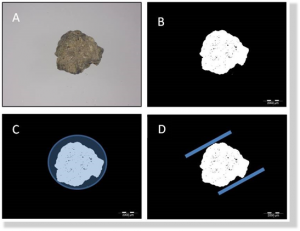Laboratory Gamma-ray Spectrometry
The Environmental Radioactivity Laboratory currently operates six High-Purity Germanium (HPGe) detectors contained within low-background lead castles that are accredited to measure a suite of radionuclides for a range of applications in environmental and radioecological research and monitoring.
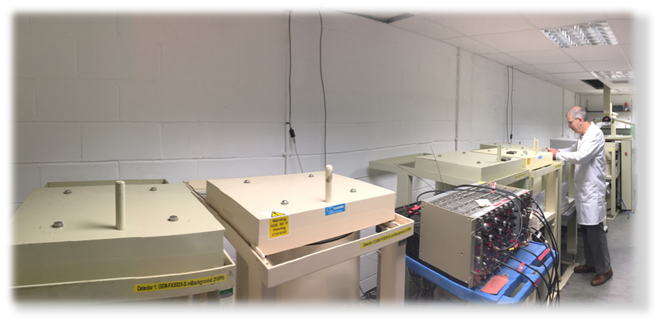
The detector types include, two low 210Pb background GEM HPGe detectors, three n-type 35% relative efficiency HPGe detectors and one n-type 70% relative efficiency HPGe detector. To ensure detection limits are maintained as low as possible, 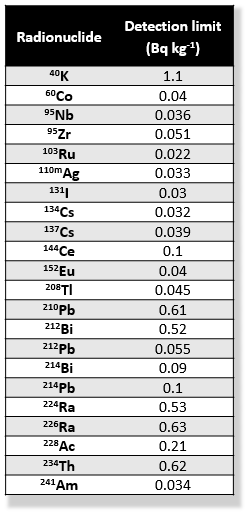 weekly background checks are undertaken alongside routine monitoring of the quality of each detector’s signal, for example Full Width at Half Maximum checks. To ensure standards are kept high, the laboratory regularly participates in International Atomic Energy Agency (IAEA) intercomparison excercises and National Physical Laboratory (NPL) proficiency tests. An example of the radionuclides being measured by ERL and typical detection limits for a 350 g water sample counted over a 174,000 seconds is provided in the above table.
weekly background checks are undertaken alongside routine monitoring of the quality of each detector’s signal, for example Full Width at Half Maximum checks. To ensure standards are kept high, the laboratory regularly participates in International Atomic Energy Agency (IAEA) intercomparison excercises and National Physical Laboratory (NPL) proficiency tests. An example of the radionuclides being measured by ERL and typical detection limits for a 350 g water sample counted over a 174,000 seconds is provided in the above table.
ERL has the additional capability to assess the activity of discrete forms of gamma-ray emitting radioactivity such as “hot” particles as well as heterogeneous substrates. This is a particular area of research that we have recently developed and are looking to further develop – at present this does not come under our accreditation.
Total Alpha and Beta Analysis
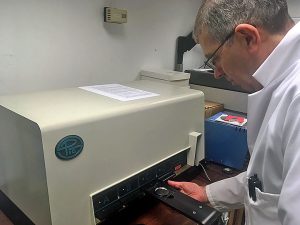 The ERL has a state of the art total alpha and beta counter: the Protean Instrument Corporation (PIC) instrument is a 4 independent chamber MPC9609 Ultra Low level alpha/beta counter (0.05 cpm alpha background & 0.45 cpm beta background). The instrument is currently undergoing calibration and verification. Once complete the ERL will be seeking UKAS accreditation for total alpha-beta testing.
The ERL has a state of the art total alpha and beta counter: the Protean Instrument Corporation (PIC) instrument is a 4 independent chamber MPC9609 Ultra Low level alpha/beta counter (0.05 cpm alpha background & 0.45 cpm beta background). The instrument is currently undergoing calibration and verification. Once complete the ERL will be seeking UKAS accreditation for total alpha-beta testing.
Autoradiography
The ERL operates a Fujifilm BAS 1500 Phosphor Imaging Plate Scanner. This provides the ability to examine the distribution of radioactivity within samples, such as cores and thin sections to an optimal resolution of 0.2 mm (depending on radiation source).
Scanning Electron Microscope-Energy Dispersive Spectroscopy (SEM-EDS)
Biological and Environmental Sciences have recently installed a new Zeiss Evo SEM with Oxford EDS (Energy Dispersive X-ray Spectroscopy) . This is a variable pressure (VP) system which allows us to image a very large range of samples both organic and inorganic. The system is equipped with both back scatter (BSD) & secondary electron (SE) detectors and can achieve resolutions of 4.5 nm @ 30 kV – BSD in VP mode and 10 nm @ 3 kV – SE. The Oxford X-Max Silicon Drift Detector (SDD) is the latest in X-Ray detection technology and allows us to perform elemental analysis on a wide range of samples. Below is an example particle imaged using this technique.
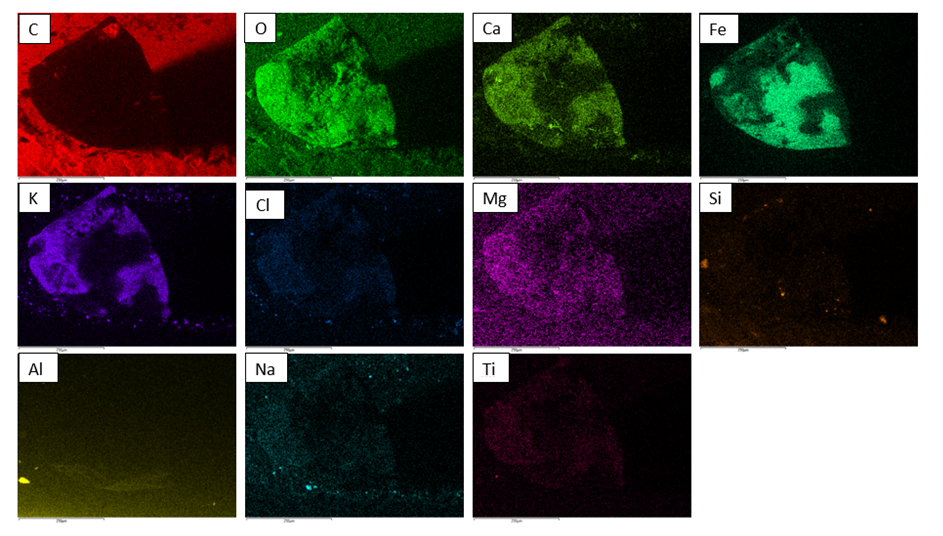
Diffraction Particle Size Analyser
Biological and Environmental Sciences operates a Coulter LS Series laser diffraction particle size analyser. The system is typically able to determine particle size from 2 mm to 0.04 µm, which can then be used to estimate a properties within the environment.
